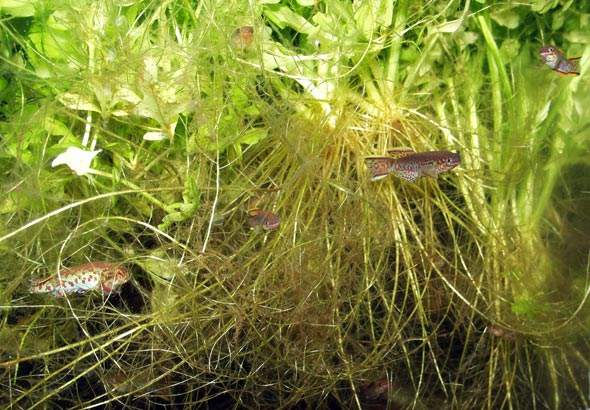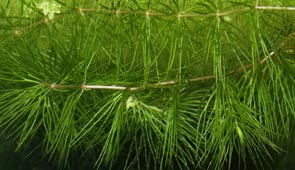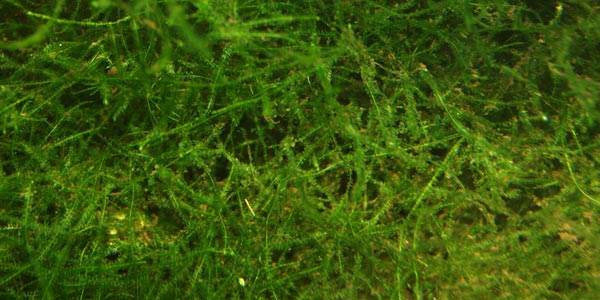

The long term method of aquarium fish breeding is really just a way of sucessfully rearing a few fry in a regular maintenance tank. It is not at all difficult, and requires no special equipment; just a reasonably sized fish tank, with plenty of hiding places and regular feedings of food capable of feeding either adult fish or fry; generally newly hatched brine shrimp (artemia). The idea is to allow a pair, or small group of adult fish to lay eggs and either raise them themselves, or allow the fry to grow up without predation from adults or larger siblings, usually by hiding. The disadvantages to this technique is the length of time it can take to see results, and the relatively small yield of fry. The resultant offspring are, however, generally very strong and healthy individuals, very well adapted to the environment in which they were born.
For certain species, cichlids that exhibit parental care, and most livebearers, getting results with this methos will be very easy indeed. For others it can more problematic. Naturally, the lower stocking density of the tank the better; a tank heaving with fish offers few hiding places and a lot of competition for food.
The first issue occurs as soon as the eggs are laid.
Many fish species will search for eggs, and some species will even watch their tank mates spawn, and move in to feed pretty much immediately. Heavy planting and dim lighting can reduce this; obviously the fewer eggs found the better, and keeping the adult fish well-fed will naturally reduce the time the spend searching. Snails (except one large apple snail - more of that later) should not be kept in the tank, as these will also eat eggs.

When left as a floating plant, Indian fern (Ceratopteris), forms thickets with roots extending down to the bottom of the tank. Far better for fry cover than when planted.
Long term breeding set ups do their absolute best when a tank is full of places to hide; specifically crevices that larger fish can barely see into, let alone enter. Naturally the precise nature of the hiding place will vary from species to species. Some rockwork will be required for cave spawners, but for egg scatterers or plant-spawners, a typical tank should be full of plants: thick pillows of Java moss, and larger clumps of Java fern, covering the lower levels, with floating cushions of Hornwort, Ceratopteris or Najas filling the middle and top levels. Of course any dense planting will do; alternatively large volumes of floating or sunken spawning mops, will also work, though plants are preferable as they host huge colonies of tiny infusoria on which hungry fry can graze. You may have noticed that all of these are non-rooted and will work in a plain bottomed tank; the plants/mops can be carefully removed in order to inspect the offspring, and prevent large feedings of Artemia or microworm from getting trapped in the substrate. Of course, any fish with specific spawning behaviour involving digging, caves, shells etc will require an appropriate substrate.


Another way of proving refuge for fry is with a porous tank separator; the holes must be large enough for fry to swim through, but not adults. Care must be taken not to allow adult fish to get through - many fish, particularly egg scattering species, will waste no time in jumping over and eating anything they can catch. Best still to keep the tank well planted, both sides of the divide.
This is really important. Many fish will happily eat their offspring, and the object of the long term spawning technique is to persuade/prevent them from doing this. As in the wild, if there is an easy meal on offer, individuals typically won't expend the energy chasing a more difficult one. So if there is a continual supply of slow moving, delicious and nutritious live foods, most fish will simply not bother chasing their fry. Herein lies the challenge - to be able to provide the required quantities of live food without polluting the tank water.
Regular feedings of newly hatched Artemia are essential. They are loved by most fish, and an excellent food; but being so small they can fit in the mouths of adults and fry alike. If a large cloud is released into the tank, all fish will have access to food. Care must be taken with light sources to keep the shrimp distributed throught the tank, and not gathered in one area. Overfeeding is actually a good idea in this case - something rarely said in fish keeping circles. After several hours any uneaten shrimp will fall to the bottom and die. This is why a single large apple snail / mystery snail and a bare bottomed tank are important. As any uneaten shrimp die, the apple snail will clear up, keeping the tank clean, and the water fresh.
Other live foods are also very much worth feeding in this kind of set up, but should not be seen as a substitute for brine shrimp nauplii
Feeding standard flake or other dry foods, whilst still possible is not ideal, as many fish might find their fry a preferable meal...
Raising fish this way is really very easy, and requires little intervention from the aquarist beyond regular feeding, assuming the correct spawning conditions (with regard water parameters) are provided. In a dimly lit, vegetation-filled tank, regularly fed baby brine shrimp, fry will almost certainly make it.
If perhaps the ideal amount of food is not offered, but there are still plenty of hiding places, or vice versa, a few fry will still most likely make it, especially in a larger tank; this is quite a forgiving method of fish breeding.
But watch out for Hydra. Hydra are a small creatures that attach themselves to a substrate and catch passing organisms. You might notice them on the front glass of the tank. Most are too small to eat fry, but in a tank regularly fed Artemia, some will do quite well, also feeding on the small shrimp. Some of these may grow to a size that they can eat fry. Commercially available treatments using Copper Sulfate or Potassium Permanganate are required to remove the infestation.